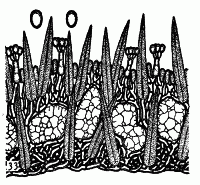|
 Hymenochaete separata Hymenochaete separata
BiostatusPresent in region - Indigenous. Non endemic
Images (click to enlarge)
Caption: FIG. 33. Hymenochaete separata G.H.Cunn. Transverse section x 500; spores x 1000. Note
masses of crystals almost separating the hymenial layer from its base. |
Article: Cunningham, G.H. (1957). Thelephoraceae of New Zealand. XIV. The genus Hymenochaete. Transactions of the Royal Society of New Zealand 85(1): 1-51.
Description: Hymenophore resupinate, annual, membranous, fragile, adnate, appearing as irregular linear
areas 2-10 x 1-2.5 cm. Hymenial surface dull umber, colliculose, deeply areolately creviced,
tending to lift at margins of crevices; margin thinning out, concolorous, fibrillose, adnate.
Context ferruginous, together with the hymenial layer 60-80 µ deep, consisting of a reddish-brown
cemented zone lying upon the substratum and bearing scattered upright hyphae
embedding masses of crystals; hyphal system monomitic; generative hyphae 2.5-3 µ
diameter, walls 0.5 µ thick, branched, septate. Setal layer occupying the whole fructification,
arranged in two rows, the upper arising from the subhymenium, the lower from the basal
zone; setae projecting to 30 µ, subulate with acute apices, 35-55 x 6-8 µ, walls naked,
reddish-brown, lumina narrow. Hymenial layer to 30 µ, deep, a close palisade of basidia and
paraphyses. Basidia cucurbitiform, a few clavate, 12-16 x 4-4.5 µ, 2-4-spored; sterigmata
arcuate, rather stout, to 4 µ long. Paraphyses subclavate, about half the length and the same
diameter as the basidia. Spores oval or broadly elliptical, 6-7 x 3.5-4 µ, walls smooth,
hyaline, 0.2 µ thick.
Habitat: HABITAT: Effused on bark of dead stems associated with a white rot.
Distribution: DISTRIBUTION: New Zealand.
Notes: Separated from others of this section by the large oval or elliptical spores, small naked setae,
narrow context and masses of embedded crystals. The hymenial surface is dingy umber and,
as the margin is concolorous, colonies are difficult to see upon dead bark. Spores are broadly
elliptical or oval, abundant, and possess one large gutta.
Crystals are so abundant as to appear in an almost continuous seam lying between the
hymenial layer and the cemented basal zone. Between them lie a few upright hyphae which
are sometimes difficult to detect.
|